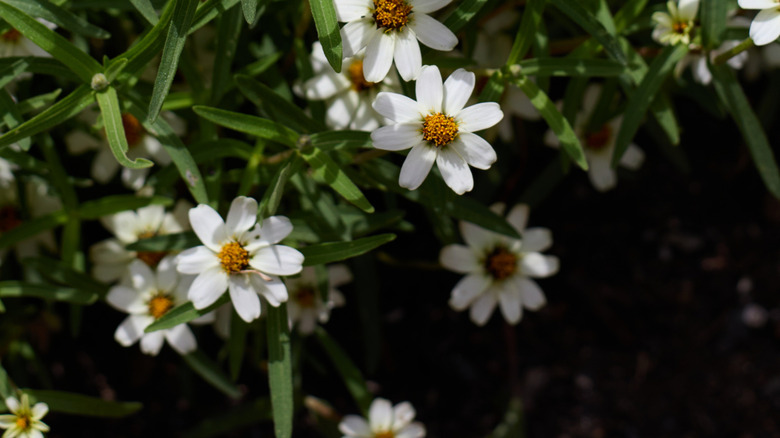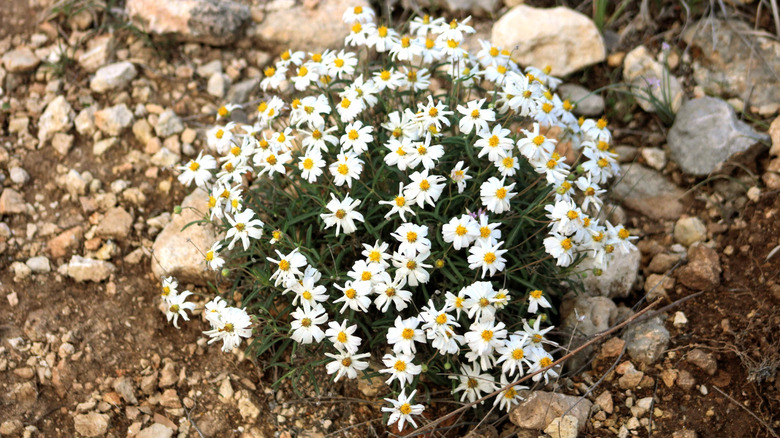The Stunning Full-Sun Flower That Can Take The Blazing Heat Of Texas Summers
Summers in Texas are no joke. With temperatures liable to jump to triple digits, gardening can become a challenge. You don't want to make the mistake of stepping out in the afternoon without a hat, a snack, and plenty of water. As much as the heat takes a toll on your own body, it takes a toll on your plants, too. Except, that is, for plants that have evolved to handle those blazing-hot conditions, like the Blackfoot daisy (Melampodium leucanthum).
Blackfoot daisy is a perennial plant that grows in a creeping pattern. It's in the Asteraceae family, which is the same as the English daisy (Bellis perennis), and it has a similar shape and color — white petals and a yellow center. However, while the English daisy can't withstand summer heat, is weedy, and is considered invasive in some parts of the U.S., the Blackfoot daisy is a heat-tolerant flower that's native to Texas. Most plants struggle to grow in conditions over 90 degrees Fahrenheit, and once triple digits arrive, they will visibly struggle. They may not be able to photosynthesize as well or get enough water, leading to wilting, or bolting. That's why plants like the Blackfoot daisy are such a great addition to Texas gardens. Even when your other veggies, fruits, and flowers need some babying to survive the heat, your Blackfoot daisies will remain blooming and thriving with little care, bringing joy and color to your garden.
Blackfoot daisies have lots to offer
Some daisies can wreak havoc in your yard, but Blackfoot daisies don't spread quickly enough to become a nuisance. They will, however, remain a bright sight in your garden that you can rely on year after year. Summers in Texas are long, with high temperatures typically starting in May and lasting through September, depending on the region. Blackfoot daisies' blooming season is even longer: they flower from early spring through late fall. The flowers are about 1-inch big, and the plant itself can reach up to 1 foot tall and about 2 feet wide. (You could use Blackfoot daisies as a drought-tolerant ground cover since they're so compact, but you won't be able to walk on it.)
In addition to their beauty, Blackfoot daisies are beneficial for local wildlife and will increase the biodiversity in your garden. They attract local pollinators like bees and butterflies in the summer, while birds feast on the seeds in the winter. They're resistant to deer and are not prone to pest problems. Caring for Blackfoot daisies is also incredibly simple, as they need little water, zero fertilizer, and only occasional pruning.
How to grow Blackfoot daisies
Blackfoot daisies are cold-hardy in USDA zones 5 to 11. They're easy to grow from seed, cuttings, or starter plants. If you're growing from seed, direct sow in the ground in the fall, or start the seeds indoors with a cold treatment in the fridge for four weeks before sowing. Plant Blackfoot daisies outside after the last frost, when the seedlings are about 6 inches tall and have not budded yet. These plants require well-draining soil above all. They prefer alkaline soil and will do well in rocky areas that aren't too fertile. Full sun is ideal, but they can thrive in light shade as well, particularly in areas where the sun beats down all day long. When sowing or transplanting, leave 1 foot of space between each plant.
Blackfoot daisies only require a few waterings over the entire summer, and monthly waterings in the winter, making them ideal for low-water gardens, xeriscaping, or just saving on your water bill. Deep watering is best. Deadheading Blackfoot daisies can be tricky, but fortunately, it's not necessary to deadhead to encourage more blooms on these flowers. They're hardy in low temperatures as well as high. Late winter is a good time to prune to prevent legginess and encourage a bushier and more compact shape.


